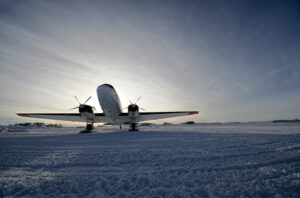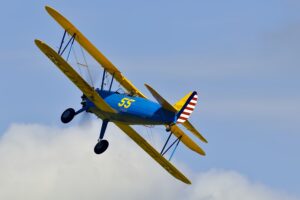Most of us have been taught that the propeller slipstream wraps around the fuselage, strikes the tail on the left side, producing a left-turning force. This has always been presented as dogma without physical evidence. In this article we present both the physics and physical evidence that the slipstream does not rotate. At the end of the article we will address some of the misconceptions that have supported this dogma. We ask you to read this section with an open mind.
Most of us have been taught that the propeller slipstream wraps around the fuselage, strikes the tail on the left side, producing a left-turning force. This has always been presented as dogma without physical evidence. In this article we present both the physics and physical evidence that the slipstream does not rotate. At the end of the article we will address some of the misconceptions that have supported this dogma. We ask you to read this section with an open mind.
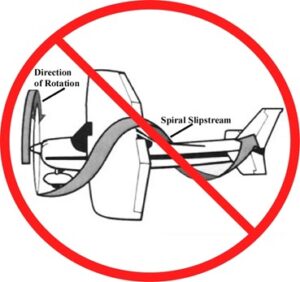
All flight textbooks and many sites on the internet describe the propeller slipstream (also sometimes referred to as prop wash) as a rotating spiral – a corkscrew – that wraps and rotates around the airplane. Thus, putting a yawing force on the vertical stabilizer, as shown in Figure 1. This mythical yawing is considered one of the four left-turning tendencies a propeller produces. But only three real left-turning properties are created by the propeller: torque, p-factor, and gyroscopic precession. We will show that the propeller slipstream is accelerated straight back from the propeller disc. Additionally, the propeller tips scribe a helical shape (not a spiral!), and the slipstream does not rotate. A helix has a constant radius, whereas a spiral’s radius increases or decreases.
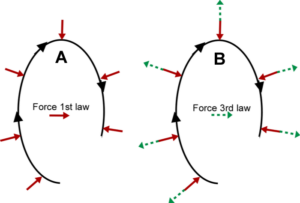
The spurious idea of a rotating spiral runs up against those pesky Newton’s Laws of Motion. Newton’s first law states: An object in motion will remain in straight-line motion unless acted on by an external force. The assumed motion of the air is not in a straight line. So, to rotate this helix (not a spiral!), a force is necessary to drive the rotation, plus an additional force at every point of the correct strength and always pointing toward the center of rotation. See Figure 2. It is hard to conceive a power source for this continually operating force. If that’s not bad enough, Newton’s third law states that if object A puts a force on object B, object B must put an equal and opposite force on object A. Referring to Figure 2, to rotate the slipstream, we need a second force to match the magically bending force. Remember, once the propeller accelerates the air, it continues to move forward; in other words, it no longer acts on the air it has accelerated. Next, we would need two objects. However, we only have one object: the air. The bottom line is the myth runs up against the buzzsaw of basic physics. There is only one object and no forces.
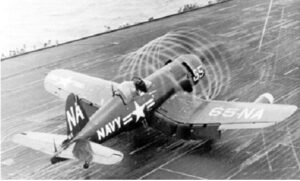
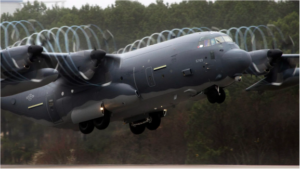
Figure 3 shows the propeller slipstreams of a C-130 Hercules, delineated by the condensation from the propeller tips. Notice the condensation helices are continuous across the top of the wings. This is clear evidence that the slipstream is moving straight back and not rotating. Otherwise, they would be disrupted by the wings. Figure 4 shows a similar behavior of the propeller slipstream of a Corsair. The condensation from the propeller tips is analogous to the wingtip vortices. The condensation from the propeller tips is analogous to visible wingtip vortices.
Also, if a rotating slipstream existed, the mythical rotation would be intercepted by the wing and disrupt the rotation. To accept the rotating slipstream hypothesis, one must accept all of the effects that would be related to it. The hypothesis is that a rotating slipstream contacts the left side of the vertical stabilizer, thereby causing a left-turning force (tendency). A rotating slipstream, however, when contacting the vertical stabilizer, would result in a right rolling motion because the contact is offset from the aircraft’s longitudinal axis. Additionally, a rotating slipstream will contact the wings with an upward motion on the left wing and a downward motion on the right wing. This would cause another right rolling motion. Added to that would be the increased Angle of Attack (AoA) of the left wing. and the decreased AoA of the right wing, further enhancing the right tolling motion. Finally, the spiraling slipstream would contact the horizontal stabilizer, causing a right rolling motion. Taken in aggregate, these right rolling forces would be quite noticeable. However, no one has ever indicated that a right rolling motion exists. If a rotating slipstream causes no right rolling motion, does it truly create a left-turning tendency? How can it be that it causes one without the other?
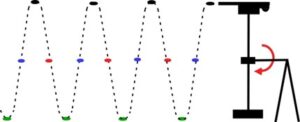
To aid comprehension, consider a rotating machine gun as shown crudely in Figure 5. It should be clear that the bullets from any orientation of the gun follow a straight path, and the totality of the bullets form a helical pattern. So, it is with the propeller slipstream. The bullets will follow a straight line whose angle is dependent on the propeller’s tip speed. That being said, this is only a visualization aid and should not be taken as more than that.
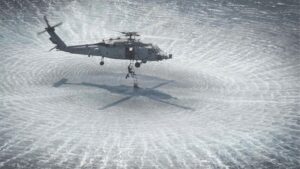
The propeller’s slipstream is the air accelerated by the propeller to produce forward thrust. It is a straightforward phenomenon. Air is accelerated essentially perpendicular to the blade’s rotation. The actual line will be a few degrees off perpendicular (approximately 4-7) and is equal to the effective angle of attack (eAoA) of the propeller or rotor, producing a forward thrust. The same phenomenon is demonstrated by a helicopter hovering over the water in Figure 6. Note that the helicopter’s blades accelerate the air straight down, and then the air spreads out radially without rotation.
As an additional verification that the slipstream does not rotate around the fuselage as depicted in many handbooks and courses, refer to Figures 7 and 8. Both airplanes are producing a smoke trail that travels straight back along the bottom of the airplane. If the spiraling slipstream myth were true, the smoke trail would be dragged around the fuselage and empennage.
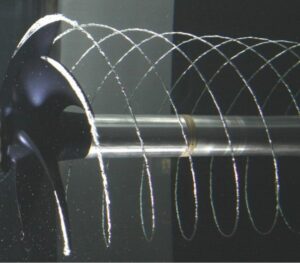
One important aspect of the spiraling slipstream myth is that, despite people examining the depiction for decades, no one seems to have noticed that the supposed rotation is going in the wrong direction. Refer to Figure 1. The sense of rotation of the slipstream is opposite to that of the propeller’s rotation. It is a slipstream of a propeller rotating in the opposite direction. Figure 9 shows the cavitation of a boat’s propeller. Looking from left to right, it is clear that the propeller is rotating counterclockwise, and the sense of rotation of the cavitation is clockwise. If the slipstream rotated, which it doesn’t, it would cause a right-not a left, turning force!
If a propeller caused a rotation slipstream, imagine how powerful a helicopter’s rotor slipstream rotation would be. Watch the Erickson Skycrane video. Notice the air is accelerated perpendicular to the rotor’s plane of rotation, and when the accelerated air contacts the water, it spreads out radially, i.e., there is no rotation.
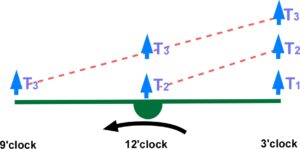
To visualize another way a left-turning propeller creates a right-turning spiral, consider Figure 10. When the propeller is at 3 o’clock (T1), it accelerates the air back. Later (T2), when the propeller is at 12 o’clock, it accelerates the air back, and the accelerated air from 3 o’clock is farther back. And when the propeller is at 9 o’clock, the air from 12 o’clock and 3 o’clock has gone farther. It is easy to see that a left-turning propeller produces a right-turning slipstream.
The Takeaway:
- Air is accelerated straight back from the propellor.
- The slipstream is a non-rotating helical shape because the propeller only covers part of the area at a time.
- The propeller tips scribe a helical shape but there is no rotation of the accelerated air; therefore, no yaw force is created.
- The widely believed and taught rotating slipstream is a myth. The perceived but non-existent rotation is an illusion that is easy to accept because the propeller is rotating. But in the end, physics wins the prize!
Common (and not so common!) misunderstandings of the propeller slipstream physics.
- Argument: the propeller “drags” the air in its direction of motion, creating a spiraling slipstream. Response: Even the Wright brothers knew that a propeller is a rotating wing. So, if a propeller dragged the air in the direction of motion, so would a wing. That is not how a wing works. It certainly would mean flight would be high-drag and very inefficient because the propeller’s energy would be directed outward at an angle, vs forward. Aircraft designers would need much more powerful engines.
Argument: the propeller slipstream spirals due to the conservation of momentum. Response: The angular momentum of the propeller is constant, and no significant angular momentum is transferred to the slipstream. The engine has to overcome the propeller’s parasite drag and induced drag. The induced drag is the work done to accelerate the air back. Both drags are in the plane of the propeller and do not add angular momentum to the slipstream. In classical propeller disk theory, there is no rotation in the slipstream.
Argument: if a torque is applied to the propeller, the air leaving the propeller must possess an angular momentum that corresponds to the applied torque, i.e., it must be rotating in the same direction as the propeller. Response: The air leaving the propeller does not have angular momentum because there are two forces that the propeller must overcome: parasite and induced drag. Parasite drag is the resistance of any object moving through the air. Induced drag is the force associated with the acceleration of the air. Neither type of drag transfers angular momentum to the air. Parasite drag is in the plane of rotation. Induced drag is essentially perpendicular to the plane of rotation (it actually occurs at the propeller’s effective angle of attach – eAoA – which is only a few degrees).
